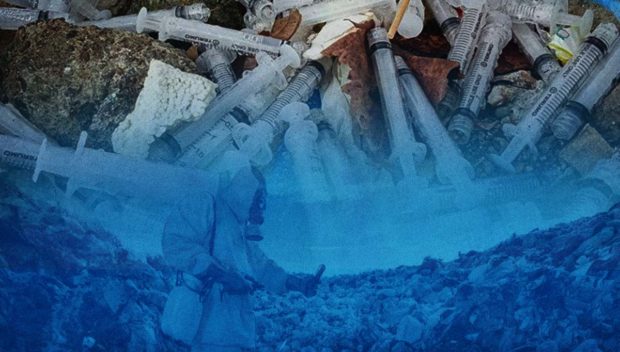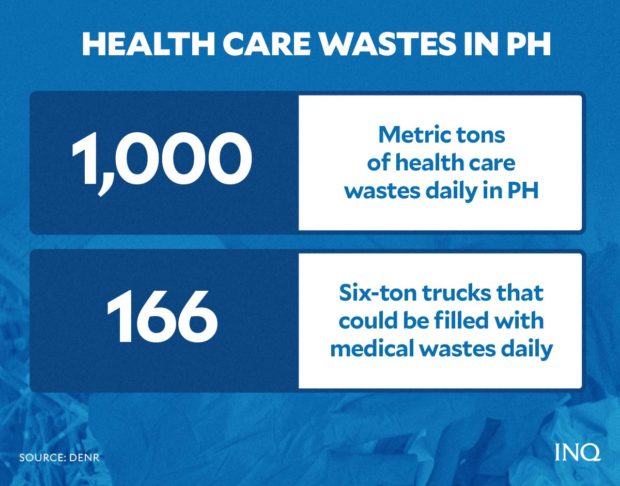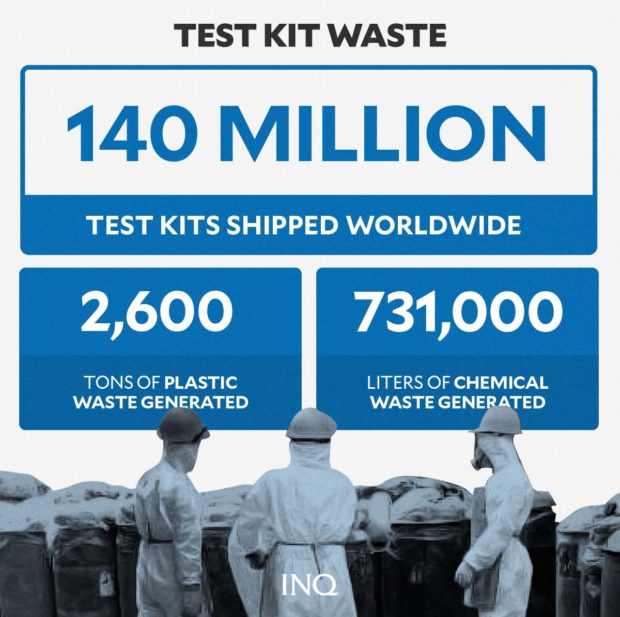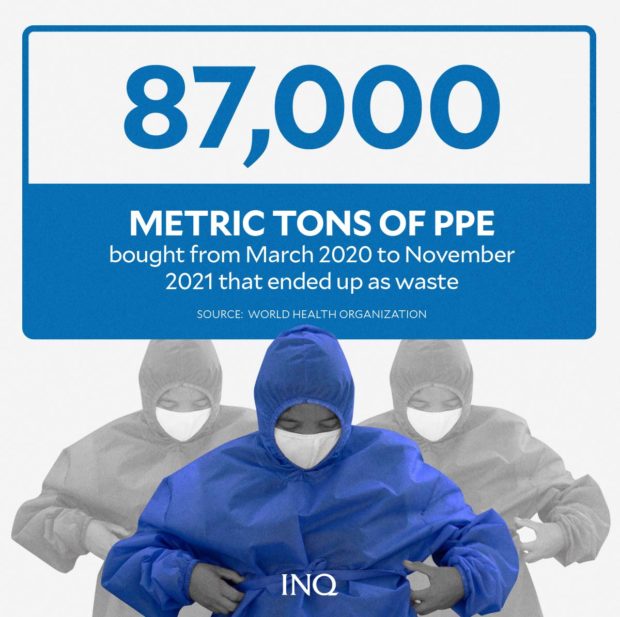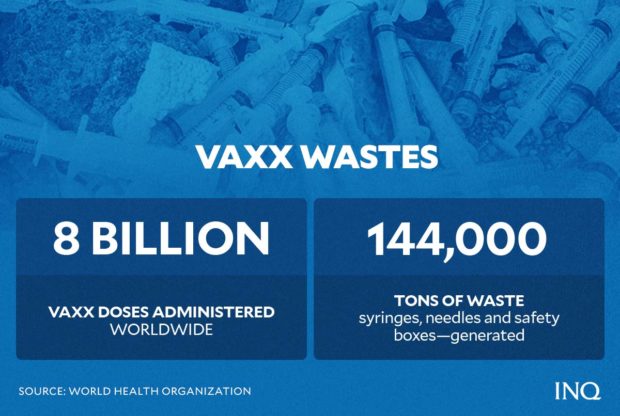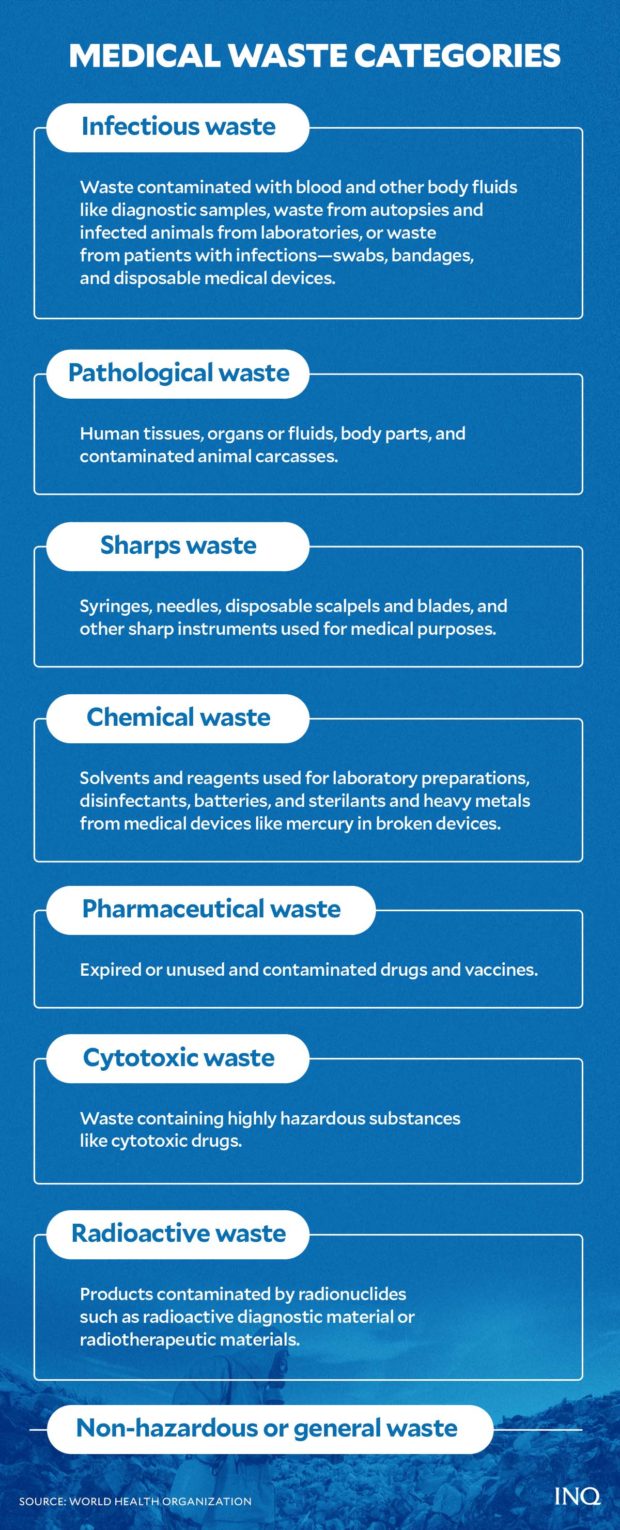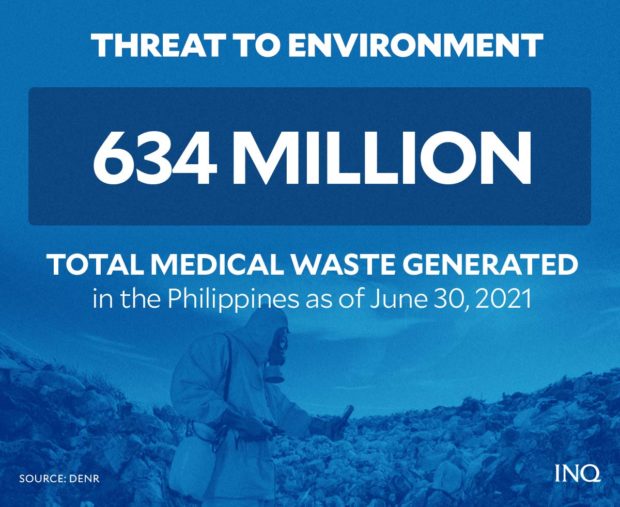Pandemic sheds light on medical waste disposal woes
MANILA, Philippines—As the world tries to reach herd immunity against the COVID virus, millions of tons of medical wastes—syringes, plastics, etc—are generated and the biggest question arises: Where do they go?
Usually, after a health care worker or medical professional administers a dose of the COVID vaccine, the used syringe will be dropped in a safety box, which the World Health Organization (WHO) described as a puncture-proof, impermeable box used to collect and safely contain used disposable or auto-disable syringes
with or without needles.
WHO added that these boxes containing empty glass or plastic vials and needles should then be transported to be incinerated, destroyed, or properly disposed of following approved procedures.
However, what if these safety boxes or used syringes were not properly disposed of? Where do they end up?
Previous instances reported across the globe showed that improperly disposed of medical wastes—which include used syringes—were found at the seabed, washed up on beaches, dumped in wastelands or even on the streets.
A similar case has recently been reported in the Philippines, which again highlighted the need for proper disposal of medical wastes, especially amid the still ongoing COVID pandemic.
COVID and medical waste
Seven children in Virac, Catanduanes, who apparently played with illegally dumped medical wastes near a village, were found positive for COVID after an antigen test last Jan. 24.
Authorities last Jan. 30 said the infected children, as well as a woman who was seen scolding the children for playing with medical waste and also tested positive, would undergo reverse transcription-polymerase chain reaction (RT-PCR) test, the more exhaustive test for the presence of SARS Cov2, the virus that causes COVID, and its variants.
Village officials had been quoted as saying that the children were playing on the shore of Purok 3 of the village, where a total of 1,978 syringes and 2,000 blood sample tubes for COVID tests and HIV test kits had been found inside a plastic garbage bag.
The officials said the medical wastes came from a diagnostic center, which was located 500 meters from the shoreline.
READ: 7 kids get COVID after playing with medical waste in Catanduanes
The Department of Health (DOH), however, clarified that if the scattered syringes were used for vaccination, it should not cause COVID or infect the children with the COVID virus.
“Like what our experts have said, our COVID-19 vaccine does not contain live virus, so if ever there will be syringes that are improperly disposed of and were touched by people, the possibility of getting infected is low,” said Health Undersecretary Maria Rosario Vergeire, speaking in Filipino, at an online media forum.
“Our vaccines definitely cannot cause COVID-19 and it will not result in a positive COVID-19 test,” said Dr. Edsel Salvana at the same forum.
Findings from a 2021 study published in the United States National Library of Medicine (NLM) at the National Institutes of Health (NIH) explained that the probability of contracting COVID through needle stick injuries is very low.
“Although there appears to be a theoretical risk of transmission of infection through blood, it is still extremely low due to low volume of blood in needlestick injuries compared to the well-known respiratory route,” the study said.
Citing a separate case report, the study detailed that an aplastic (failure of organs to function properly) anemia patient, who had received blood plasma platelet transfusion from a person who later on tested positive for COVID, “did not demonstrate any transfusion-related COVID-19 infection.”
“Hence, the fear over transmission of infection by needle stick injury seems unwarranted.”
Injuries from needles used in medical procedures are called needlesticks or sharps injuries.
Still, illegally dumping or improper disposal of used syringes and other medical wastes remained to be a constant problem in the Philippines and elsewhere and is being heightened by the pandemic.
Long-standing issue
According to Maggie Montgomery, a WHO technical officer, health care waste loads in facilities around the world have increased “up to ten times” amid the COVID pandemic.
A WHO report said around 87,000 metric tons of personal protective equipment (PPE), which have been procured between March 2020 to November 2021, have ended up as waste.
It also pointed out that over 140 million test kits, which have been shipped worldwide, had the potential to generate 2,600 tons of non-infectious waste—mainly plastic—and 731,000 liters of chemical waste—equivalent to one-third of an Olympic-size swimming pool.
Over 8 billion doses of the COVID vaccine administered globally were also found to produce at least 144,000 tons of additional waste in the form of syringes, needles, and safety boxes.
READ: Huge volumes of COVID medical waste threaten health – WHO
In the Philippines, at least 1,000 metric tons of medical wastes were being collected daily amid the pandemic, according to a recent report by the Department of Environment and Natural Resources (DENR).
Environment Undersecretary Jonas Leones said the medical waste collected daily could fill 166 six-ton trucks.
The DENR added that medical waste in the country increased after the government mandated the use of face masks.
READ: DENR: Medical waste reaches 1k tons daily amid devolution
READ: DENR collects 1,000 metric tons of medical waste per day, equivalent to 166 trucks
Data from the DENR showed that as of June 30, 2021, the total generated health care waste in the Philippines has reached 634,000,687.73 metric tons. The department also emphasized the country’s lack of treatment, storage and disposal (TSD) facilities, which are requirements in handling the mountain of medical wastes being generated every day.
“Our TSD facilities are not enough to cater to the health care waste generated nationwide,” said Visminda Osorio, DENR-Environmental Management Bureau assistant director, in September last year.
Osorio said there are currently only 10 TSDs capable of treating medical wastes in eight regions—Central Luzon, NCR, Calabarzon, Ilocos Region, Bicol Region, Central Visayas, Eastern Visayas and Northern Mindanao.
“Right now, what we are doing is those health care waste facilities are advised to do the initial disinfection prior to disposal, and part of the regions that have no TSD facility, they do it through safe burial or concrete vaulting within the premises,” she added.
READ: PH treatment facilities ‘not enough’ to handle healthcare waste
Instances of improperly discarded medical wastes had been around even before the pandemic.
In 2019, authorities discovered medical wastes like used syringes, kidney trays, chemical bottles, tubes containing blood samples, and several gloves near the shores of Barangay Ibo in Lapu-Lapu City, Cebu province.
The DENR in Central Visayas had to scour the seas around Mactan Island for more hospital wastes.
READ: DENR scours Mactan waters for waste from Cebu hospital
READ: Firm, hospital face fines for medical waste at sea
A year before, medical wastes—syringes, dextrose bottles, vials and biological waste—were found floating on a creek at Barangay Taloy Sur in Tuba town, Benguet province.
READ: Hospital charged for medical waste
READ: Medical waste polluting Benguet creek
Health and environmental risks
Waste and by-products generated by health care procedures can be categorized into eight different types, according to WHO. These include:
- Infectious waste: waste contaminated with blood and other bodily fluids such as discarded diagnostic samples, waste from autopsies and infected animals from laboratories, or waste from patients with infections—swabs, bandages, and disposable medical devices.
- Pathological waste: human tissues, organs or fluids, body parts, and contaminated animal carcasses.
- Sharps waste: syringes, needles, disposable scalpels and blades, and other sharp instruments used for medical purposes.
- Chemical waste: solvents and reagents used for laboratory preparations, disinfectants, batteries, and sterilants and heavy metals contained in medical devices such as mercury in broken devices.
- Pharmaceutical waste: expired or unused and contaminated drugs and vaccines
- Cytotoxic waste: waste containing highly hazardous substances such as cytotoxic drugs.
- Radioactive waste: products contaminated by radionuclides such as radioactive diagnostic material or radiotherapeutic materials.
- Non-hazardous or general waste
“Health care waste contains potentially harmful microorganisms that can infect hospital patients, health workers, and the general public,” WHO said.
“Other potential hazards may include drug-resistant microorganisms which spread from health facilities into the environment,” it added.
Health care wastes and by-products could also cause chemical burns and radiation burns and could be hazardous due to potential toxic exposure to substances, like mercury or dioxins.
Sharps-inflicted injuries, including needlesticks, were also found to be responsible for around 33,800 new HIV infections, 1.7 million hepatitis B infections, and 315,000 hepatitis C infections in 2010.
“A person who experiences one needle stick injury from a needle used on an infected source patient has risks of 30%, 1.8%, and 0.3% respectively of becoming infected with HBV, HCV, and HIV,” WHO said.
Improperly discarded medical wastes could also pose health risks indirectly as they contaminate and pollute the environment.
The WHO warned that disposal of untreated health care wastes in landfills—if those landfills are not properly constructed—could cause contamination of drinking, surface, and ground waters.
Using chemical disinfectants for the treatment of health care wastes could also lead to the release of hazardous substances into the environment “if those substances are not handled, stored and disposed of in an environmentally sound manner.”
While incineration of waste has been widely practiced to dispose of medical wastes and byproducts, WHO said that inadequate incineration, or the incineration of unsuitable materials, results in the release of pollutants into the air and in the generation of ash residue.
“Incinerated materials containing or treated with chlorine can generate dioxins and furans, which are human carcinogens and have been associated with a range of adverse health effects,” WHO explained.
“Incineration of heavy metals or materials with high metal content (in particular lead, mercury, and cadmium) can lead to the spread of toxic metals in the environment,” it added.
The DOH, in the wake of reports about medical waste mishandling, urged health care facilities and local government units (LGUs) to properly dispose of medical waste.
“We are not going to tolerate this kind of irresponsible behavior because it can cause harm to other citizens,” Vergeire said.
“We would like to remind our facilities, laboratories, hospitals and [LGUs]: We have a law that covers these kinds of violations. We also have policies to guide you on what you’re supposed to do with these wastes,” she added.
READ: Mind your medical waste, DOH warns hospitals, local governments
According to DENR, health care wastes are usually collected at every barangay and are transported to a temporary transfer station. The municipal government then gets the waste and brings it to the treatment facility before it is directed to the final disposal site.
The final disposal site would either be the landfill or the storage area in treatment facilities.
TSB
For more news about the novel coronavirus click here.
What you need to know about Coronavirus.
For more information on COVID-19, call the DOH Hotline: (02) 86517800 local 1149/1150.
The Inquirer Foundation supports our healthcare frontliners and is still accepting cash donations to be deposited at Banco de Oro (BDO) current account #007960018860 or donate through PayMaya using this link.
